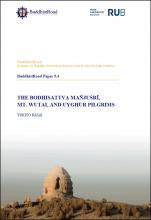BuddhistRoad Paper 5.4 "The Bodhisattva Mañjuśrī, Mt. Wutai, and Uyghur Pilgrims"
Synopsis
Once Mt. Wutai, or Five-Peak-Mountain, was recognised as the Bodhisattva Mañjuśrī’s domicile in this world, that mountain became a popular pilgrimage destination in China. During the Tang period, the special status of that bodhisattva as state protector was reinforced through the Tang emperors’ Buddhist legitimation strategies, and the mountain enjoyed prosperity under royal patronage. Over time, the flourishing Mañjuśrī cult at Mt. Wutai was transmitted to Eastern and Central Asia. Some rulers in Eastern and Central Asia who legitimated their rule in Buddhist contexts seem to have been aware of the special status of the Mañjuśrī cult at Mt. Wutai for themselves and their states. However, the Uyghur rulers seem to have differed because they relied upon non-Buddhist legitimation strategies. The Mañjuśrī cult at Mt. Wutai flourished among Uyghur Buddhists during the Mongolian period. In that period, pilgrims from various regions, including the Uyghurs, visited the mountain. The activities of those pilgrims spread information about the Mañjuśrī cult at Mt. Wutai throughout Eastern and Central Asia.
Chinese Translation
作为文殊菩萨在世间的道场, 五台山便成为了中国著名的朝圣地. 唐朝时, 文殊菩萨作为国家怙主的特殊地位经由唐朝皇帝的佛教合法化策略得到了加强, 该山在皇家的供养下享受着尊荣. 随着时间的推移, 五台山蓬勃发展的文殊信仰被传到了东亚和中亚. 东亚和中亚的一些统治者借用佛教而合法化了其统治—他们似乎已经意识到五台山的文殊信仰对他们自己及其政权的特殊作用. 然而, 回鹘统治者似乎有所不同, 因为他们依靠的是非佛教的合法化策略. 蒙元时期, 五台山的文殊信仰在回鹘佛教徒中盛行. 那时, 不同地区的朝圣者们, 包括回鹘人, 都往五台山朝圣. 这些朝圣者的活动将五台山的文殊信仰传播到了整个东亚和中亚.

Downloads
Published
Categories
License

This work is licensed under a Creative Commons Attribution-NonCommercial-NoDerivatives 4.0 International License.

